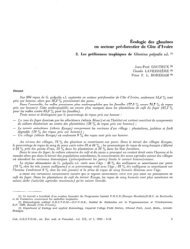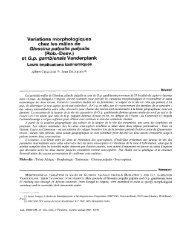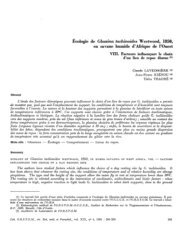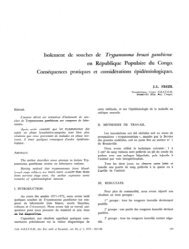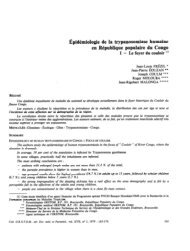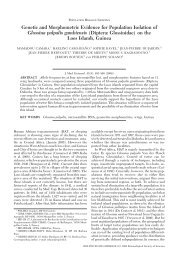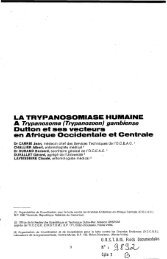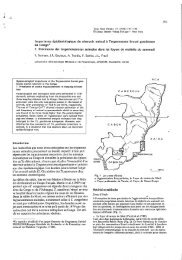Mixed populations of Trypanosoma brucei in wild Glossina palpalis ...
Mixed populations of Trypanosoma brucei in wild Glossina palpalis ...
Mixed populations of Trypanosoma brucei in wild Glossina palpalis ...
Create successful ePaper yourself
Turn your PDF publications into a flip-book with our unique Google optimized e-Paper software.
<strong>Mixed</strong> <strong>populations</strong> <strong>of</strong> <strong>Trypanosoma</strong> <strong>brucei</strong><br />
<strong>in</strong> <strong>wild</strong> Glossba <strong>palpalis</strong> <strong>palpalis</strong><br />
313<br />
-<br />
I<br />
J. R. Stevens, E Mathieu-Daudk, J. J. McNamaraI, X H..Mizenl, A. Nzila2<br />
UMR CNRS /ORSTOM 9926: Génétique Moléculaire des Parasites et des Insectes Vecteurs, Montpellier, France;<br />
MRC Trypanosomiasis Research Group, Division <strong>of</strong> Molecular and Cellular Biology, University <strong>of</strong> Bristol, Langford, UK;<br />
Département Santé, ORSTOM, Montpellier, France<br />
'<br />
I<br />
I<br />
/<br />
Abstract<br />
In many previous characterization studies<br />
<strong>of</strong> Trypanozoon, isolates have been subpassaged<br />
numerous times <strong>in</strong> laboratory rodents until a quantity<br />
<strong>of</strong> trypanosomes sufficient for analysis has been obta<strong>in</strong>ed.<br />
In addition to the numerous biochemical effects<br />
<strong>of</strong> such a process on the parasite, it appears probable<br />
that adaptation to an unnatural host may also serve to<br />
filter out less virulent <strong>populations</strong> from mixed <strong>in</strong>fections,<br />
lead<strong>in</strong>g to an underestimate <strong>of</strong> the true level <strong>of</strong><br />
genetic diversity. By the early clon<strong>in</strong>g <strong>of</strong> trypanosomes<br />
from susceptible captive flies <strong>in</strong>fected from the primary<br />
isolate -the midgut <strong>of</strong> a <strong>wild</strong> tsetse -the present study<br />
provides evidence <strong>of</strong> the range <strong>of</strong> genetically different<br />
Trypanoso<strong>in</strong>a <strong>brucei</strong> <strong>populations</strong> which may coexist<br />
with<strong>in</strong> the midgut <strong>of</strong> <strong>in</strong>dividual tsetse flies <strong>in</strong> nature.<br />
The three primary isolates from tsetse yielded one, five<br />
and n<strong>in</strong>e genetically dist<strong>in</strong>ct <strong>populations</strong>. Cloned <strong>populations</strong><br />
were confirmed as T <strong>brucei</strong> us<strong>in</strong>g the polymerase<br />
cha<strong>in</strong> reaction, and were characterized by<br />
karyotype analysis and multilocus isoenzyme electrophoresis.<br />
These data allowed a limited assessment <strong>of</strong><br />
the level <strong>of</strong> genetic variability <strong>in</strong> natural <strong>populations</strong> <strong>of</strong><br />
T. <strong>brucei</strong>.<br />
Introduction<br />
Demite several studies <strong>of</strong> naturally Occurr<strong>in</strong>g<br />
mixed <strong>in</strong>feckons <strong>of</strong> <strong>Trypanosoma</strong> (Trypdnozoon)<br />
bruceì <strong>in</strong> mammalian hosts (Scott, 1981; MehIitz et al.,<br />
1982), studies <strong>of</strong> mixed <strong>populations</strong> <strong>of</strong> trypanosomes <strong>in</strong><br />
<strong>wild</strong> caught tsetse flies have been less fkequently reported<br />
(Letch, 1984; Godfrey et al., 1990; Majiwa and Otieno,<br />
1990). Given the importance <strong>of</strong> the tsetse fly as the probable<br />
site <strong>of</strong> genetic exchange <strong>in</strong> trypanosomes (Jenni et<br />
al., 1986), this represents a potentially serious gap <strong>in</strong> our<br />
understand<strong>in</strong>g <strong>of</strong> the disease, particularly when consider<strong>in</strong>g<br />
genetic variability with<strong>in</strong> Trypanozoon. Furthermore,<br />
<strong>in</strong> previous studies <strong>of</strong> genetic variation with<strong>in</strong> natural <strong>in</strong>fections<br />
<strong>of</strong> T bruceì from tsetse (Letch, 1984; Godfrey et<br />
al., 1990), parasites were <strong>in</strong>oculated directly <strong>in</strong>to laboratory<br />
rodents; clones were then made from samples taken<br />
Accepted: 1 June 1994<br />
II<br />
> Trop. Med. Parasitol. 45 (1994) 313-318 - v<br />
O Georg Thieme Verlag Stuttgart . New York<br />
at <strong>in</strong>tervals <strong>of</strong> several days dur<strong>in</strong>g the parasitaemic cycle.<br />
Thus, certa<strong>in</strong> <strong>populations</strong> which were less well adapted<br />
for growth <strong>in</strong> experimental mice may already have been<br />
overgrown, and perhaps elim<strong>in</strong>ated, by the time the frst<br />
samples were taken.<br />
Th% present study addresses this problem<br />
by clon<strong>in</strong>g and grow<strong>in</strong>g procyclic trypanosomes derived<br />
from susceptible laboratory flies <strong>in</strong>fected from the primary<br />
isolate - the midgut <strong>of</strong> a <strong>wild</strong> tsetse. The cloned<br />
<strong>populations</strong> were confrmed as T<strong>brucei</strong> us<strong>in</strong>g the polymerase<br />
cha<strong>in</strong> reaction (PCR), and were characterized by<br />
karyotype analysis and multilocus isoenzyme electrophoresis<br />
(MLEE). These data allowed a limited assessment<br />
<strong>of</strong> the level <strong>of</strong> genetic variability occurr<strong>in</strong>g naturally<br />
<strong>in</strong> T. <strong>brucei</strong>. Results are discussed <strong>in</strong> relation to other<br />
studies on reproductive processes <strong>in</strong> field <strong>populations</strong> <strong>of</strong><br />
Trypanozoon (Tait, 1980; Gibson, 1990; Tibayrenc et al.,<br />
1990; Cibulskis, 1992; Stevens and Weburn, 1993).<br />
Materials and methods<br />
l?ypanosome orig<strong>in</strong>s. The orig<strong>in</strong>s <strong>of</strong> the three<br />
stocks and the 29 clones made from them are presented <strong>in</strong><br />
Table 1, together with WHO codes and <strong>in</strong>formation on the three<br />
standard stocks.<br />
Trypanosomes were isolated from Gloss<strong>in</strong>a na/-<br />
I---<br />
palis <strong>palpalis</strong> caught <strong>in</strong> Challier traps <strong>in</strong> and around the village<br />
<strong>of</strong> Kouassi-Perita, near Bouaflé, central Côte d'Ivoire <strong>in</strong> June<br />
1989 (Mehlitz and Schares, personal communication); a detailed<br />
description <strong>of</strong> the area is provided by Mehlitz et al., (1981).<br />
Parasites were isolated from tsetse midguts (Mehlitz and Scha.ren.<br />
personal communication) and transferred to supplemented<br />
Cunn<strong>in</strong>gham's medium (Cunn<strong>in</strong>gham, 1977) as described by<br />
Dukes et al. (1989); isolates were cryopreserved before despatch<br />
to Europe. Stabilates <strong>of</strong> the three primary isolates were k<strong>in</strong>dly<br />
collected and provided by the research teams <strong>of</strong> Pr<strong>of</strong>essor D.<br />
Mehlitz, Free University <strong>of</strong> Berl<strong>in</strong> and Dr. I. Maudl<strong>in</strong>, Tsetse<br />
Research Laboratory CTRLI, Bristol.<br />
-_..__<br />
__,<br />
Procyclic clon<strong>in</strong>g and growth <strong>in</strong> culture. Stabilates<br />
were thawed and washed by centrifugation <strong>in</strong> SM culture<br />
medium (Cunn<strong>in</strong>gham, 1977). Trypanosomes were then resuspended<br />
<strong>in</strong> 1.0 ml SM, half <strong>of</strong> which was removed to one well <strong>of</strong><br />
a 24 well culture plate, and <strong>in</strong>cubated at 27°C <strong>in</strong> 5% COZ enriched<br />
air; the rema<strong>in</strong>der was fed to laboratory G. morsitans<br />
morsitans (TRL colony FX9) as described previously (McNamara<br />
and Snow, 1991). Where trypanosomes failed to grow directly<br />
fi-om the primary isolate they were re-isolated <strong>in</strong>to culture medium<br />
from the midguts <strong>of</strong> laboratory flies. To m<strong>in</strong>imise the potential<br />
loss <strong>of</strong> less virulent trypanosome stra<strong>in</strong>s from any mixed<br />
<strong>in</strong>fections, midgut cultures <strong>in</strong> the first stage <strong>of</strong> exponential
314 Trop. Med. Parasitol. 45(1994) J. R. Stevens, E Mathieu-Daudé, J. J. McNamara et al.<br />
-<br />
Table 1 Isolate details.<br />
WHO Code Short Code Host Cloned <strong>populations</strong> Reference<br />
GPAP/C1/89/KP 13 KP 13 G.p.<strong>palpalis</strong> 5 (Nos 1-5)<br />
GPAP/ CI /89 / KP 14 KP 14 C.p.<strong>palpalis</strong> 9 (NOS 1 -9)<br />
GPAP/C1/89/KP 33 KP 33 G.p.<strong>palpalis</strong> 15 (NOS 1-10, 12-16)<br />
Standard stocks:<br />
GPAPICII82IKP 2-2 CI. 38 KP 2 G. p. <strong>palpalis</strong> Letch, 1984<br />
MHOM/C1/78/TH 1-037 TH 1 Man -<br />
Mehlitz et al., 1982<br />
MHOM/SD/82/BIYAMINA CI. B BlYAMlNA Man -<br />
Godfrey et al., 1987<br />
b<br />
1 2 3 4 5 6 7-8 9~18111213141516<br />
megaba<br />
:l.IMb<br />
:0.4Mb<br />
Fig. 1 Molecular karyotypes <strong>of</strong> cloned trypanosome <strong>populations</strong> <strong>of</strong><br />
isolate GPAP/C1/89/KP 33; uncloned parental stock, lane 2; clones<br />
1-14, lanes 3-16. Two karyotypes can be dist<strong>in</strong>guished by the presence<br />
or absence <strong>of</strong> chromosome bands <strong>in</strong> the megabase (a) and<br />
400 kb (b) regions <strong>of</strong> the gel. Marker shown <strong>in</strong> lane 1.<br />
growth were diluted with fresh SM to give a trypanosome concentration<br />
<strong>of</strong> 103-104ml-1; clones were made by direct observation<br />
<strong>of</strong> s<strong>in</strong>gle parasites <strong>in</strong> a 0.5 J drop <strong>of</strong> medium <strong>in</strong> a well <strong>of</strong> a<br />
microtitre plate. Immediately after the presence <strong>of</strong> a s<strong>in</strong>gle organism<br />
had been confirmed by a second observer the well was<br />
flooded with 100 pl <strong>of</strong> SM; the process was repeated until up to<br />
35 clones had been prepared. Plates were <strong>in</strong>cubated at 27 ‘C <strong>in</strong><br />
5 % CO2 enriched air, and, if clon<strong>in</strong>g was successful, the trypanosomes<br />
were subcultured <strong>in</strong>to progressively larger volumes <strong>of</strong> medium.<br />
Thereafter, cultures were ma<strong>in</strong>ta<strong>in</strong>ed at 106 trypanosomes<br />
ml-1, at 28 ‘C for 6-10 days (Dukes et al., 1989). Once<br />
a culture exceeded 2 x 109 trypanosomes <strong>in</strong> 120-15Oml <strong>of</strong> medium,<br />
it was harvested (Gray et al., 1987). F<strong>in</strong>ally, trypanosomes<br />
were lysed, and centrifuged to separate the water soluble<br />
enzymes from the trypanosome debris. The supernatant conta<strong>in</strong><strong>in</strong>g<br />
the enzymes was removed and stored as beads <strong>in</strong> liquid<br />
nitrogen (Gibson et al., 1980), while the solid material was reta<strong>in</strong>ed<br />
for DNA extraction.<br />
PCR primer analysis. Total trypanosome DNA<br />
was prepared accord<strong>in</strong>g to standard methods (Van der Ploeg et<br />
al., 1982). Oligonucleotide primers designed to anneal specifically<br />
to the satellite DNA <strong>of</strong> a particular species (Moser et al., 1989;<br />
Masiga et al., 1992) were used to check that all <strong>populations</strong> were<br />
i“. <strong>brucei</strong>. Populations were also checked with I: congolense<br />
(Savannah type) and I: simiae PCR primers; reaction conditions<br />
were as described by Masiga et al. (1992).<br />
Karyotype analysis. Trypanosomes grown <strong>in</strong><br />
culture were lysed <strong>in</strong> situ <strong>in</strong> agarose blocks at a Enal concentration<br />
<strong>of</strong> 2xlOgml-1 (Van der Ploeg et al., 1984). Chromosome<br />
sized fragements <strong>of</strong> DNA were size fractionated <strong>in</strong> a 1 % agarose<br />
gel us<strong>in</strong>g an LKB Pulsaphor system with a hexagonal electrode<br />
array. The program used had five phases (900 s, 15 h; 300 s, 15<br />
h; 210 s, 10 h; 180 s, 10 h; 40 s, 10 h) and a runn<strong>in</strong>g time <strong>of</strong> 60 h<br />
at 130V. Gels were sta<strong>in</strong>ed with ethidium bromide and photographed<br />
by ultraviolet transillum<strong>in</strong>ation (Fig. 1).<br />
* ,. Enzyme range. Electrophoresis was carried out<br />
on cellulose acetate plates (CAE) (Mathieu-Daudé, 1991; Ben Abderrazak<br />
et al., 1993). The follow<strong>in</strong>g 15 enzyme systems were<br />
exam<strong>in</strong>ed: EC 1.6.-.-, Diaphorase (DIA); EC1.l.l.lO, Threon<strong>in</strong>e<br />
dehydrogenase (TDH); EC1.1.1.37, malate dehydrogenase<br />
(MDH); EC 1.1.1.40, “malic” enzyme (ME); EC 1.1.1.42, isocitrate<br />
dehydrogenase OCD); EC 1.1.1.44, phsophogluconate dehydrogenase<br />
(6PGD); EC 1.1.1.49, Glucose-6-phosphate dehydrogenase<br />
(G6PDH); EC 1.2.1.12, Glyceraldehyde-3-phosphate dehydrogenase<br />
(GAPDH); EC 2.6.1.1, aspartate am<strong>in</strong>otransferase (MAT);<br />
EC 2.7.5.1, phosphoglucomutase (PGM); EC 3.2.2.1, two nucleoside<br />
hydrolases us<strong>in</strong>g different substrates; the enzyme utiliz<strong>in</strong>g<br />
<strong>in</strong>os<strong>in</strong>e was coded NHI (previously labelled as NH; Gibson et<br />
al., 1980; Godfrey et al., 1990) and that utiliz<strong>in</strong>g deoxy<strong>in</strong>os<strong>in</strong>e,<br />
NHD; EC 3.4.11.-. or .13.-, Leuc<strong>in</strong>e am<strong>in</strong>opeptidase (LAP); EC<br />
3.4.11.-. or .13.-, peptidase, substrate: L-leucyl-L-alan<strong>in</strong>e (PEP,);<br />
EC 5.3.1.9, glucose phosphate isomerase (GPI).<br />
Numerical analysis. A similarity matrix was<br />
produced accord<strong>in</strong>g to Jaccard’s method (1908) us<strong>in</strong>g a computer<br />
program (Stevens and Cibulskis, 1990). Similarity values were<br />
calculated us<strong>in</strong>g all isoenzyme bands for each enzyme, between<br />
each pair <strong>of</strong> <strong>populations</strong>; parental stocks were not <strong>in</strong>cluded as<br />
they were, by def<strong>in</strong>ition, composites <strong>of</strong> the cloned <strong>populations</strong><br />
under study. A dendrogram was constructed by the unweighted<br />
pair-group method us<strong>in</strong>g arithmetic averages (UPGMA; Fig. 2).<br />
Results<br />
Clon<strong>in</strong>g <strong>of</strong> stocks<br />
None <strong>of</strong> the cultures <strong>in</strong>itiated directly from<br />
the’primary isolates grew; only those stocks which were<br />
successfully re-isolated from laboratory flies were cloned.<br />
Furthermore, despite standardized procedures and conditions,<br />
e. g. cultures <strong>in</strong> the same early growth stage, clon<strong>in</strong>g<br />
efficiencies varied between 14 % (GPAP/CI/89/KP 14)<br />
and 48 % (GPAP/CI/89/KP 33).<br />
. PCR primers<br />
Analysis <strong>of</strong> parasite DNA with PCR primers<br />
(Moser et al., 1989; Masiga et al., 1992) confirmed all<br />
stocks, both parental and cloned <strong>populations</strong>, as I: <strong>brucei</strong>,
<strong>Mixed</strong> Populations <strong>of</strong> Z <strong>brucei</strong> <strong>in</strong> <strong>wild</strong> G. <strong>palpalis</strong> <strong>palpalis</strong> Trop. Med. Parasitol. 45 (1994)-<br />
315<br />
Controls, <strong>populations</strong> tested with the Z congolense<br />
(Savannah type) and I: simiae probes, were negative.<br />
Molecular karyotype analysis<br />
The three uncloned <strong>populations</strong>, GPAP/CI/<br />
89/KP 13, GPAP/CI/89/KP 14 and GPAP/CI/89/KP 33,<br />
had dist<strong>in</strong>ct karyotypes. However, only KP 33, which<br />
yielded two dist<strong>in</strong>ct karyotypes, produced clones with<br />
different chromosome band<strong>in</strong>g patterns (Fig. 1).<br />
Isoenzymes: zymodemes<br />
The isoenzyme band<strong>in</strong>g patterns obta<strong>in</strong>ed<br />
were coded accord<strong>in</strong>g to Mathieu-Daudé (1991) and Truc<br />
et al. (1991). Us<strong>in</strong>g the fifteen enzyme systems, <strong>in</strong>terpreted<br />
as 17 loci (see <strong>in</strong>terpretation), 17 zymodemes were<br />
recognised <strong>in</strong> the 35 <strong>populations</strong> analysed (Fig. 2), <strong>in</strong>clud<strong>in</strong>g<br />
the standard stocks. Sample <strong>populations</strong>, <strong>in</strong>clud<strong>in</strong>g<br />
parental stocks, were classified <strong>in</strong>' 15 zymodemes; cloned<br />
<strong>populations</strong> were classed <strong>in</strong> 14 zymodemes. Full details <strong>of</strong><br />
these isoenzyme data are available on request from J. R.<br />
Stevens.<br />
The follow<strong>in</strong>g seven loci were <strong>in</strong>variant<br />
and monomorphic for the 35 <strong>populations</strong> (<strong>in</strong>clud<strong>in</strong>g three<br />
standard <strong>populations</strong>) studied: GPI, MEA, NHIA, NHIB,<br />
NHD, TDH, MDH. Among the 32 sample <strong>populations</strong> an<br />
eighth enzyme, LAP, was also <strong>in</strong>variant and monomorphic.<br />
The parental population <strong>of</strong> KP 13 and all five cloned<br />
<strong>populations</strong> were enzymatically identical, and were<br />
placed <strong>in</strong> zymodeme 4. The n<strong>in</strong>e cloned <strong>populations</strong> <strong>of</strong> KP<br />
14 were classified <strong>in</strong> five zymodemes; the parental stock<br />
was classified <strong>in</strong> the same zymodeme (25) as two <strong>of</strong> it's<br />
cloned <strong>populations</strong>. The ffteen cloned popdations <strong>of</strong> KP<br />
33 were classified <strong>in</strong> n<strong>in</strong>e zymodemes, while the parental<br />
stock was placed <strong>in</strong> a separate zymodeme (210); one<br />
cloned population was placed <strong>in</strong> 24 with all <strong>populations</strong><br />
<strong>of</strong> KP 13.<br />
Due to the large number and selection <strong>of</strong><br />
enzyme systems exam<strong>in</strong>ed <strong>in</strong> the current study, the direct<br />
match<strong>in</strong>g <strong>of</strong> zymodemes with those described <strong>in</strong> previous<br />
studies (Godfrey et al., 1990; Stevens et al., 1992; Truc<br />
and Tibayrenc, 1993) was not possible. Indeed, as Tibayrenc<br />
and Ayala (1988) po<strong>in</strong>t out, del<strong>in</strong>eation <strong>of</strong> zymodemes<br />
is highly dependent upon the methods used,<br />
and upon the range <strong>of</strong> isoenzyme markers under study.<br />
This was particularly true for comparisons made with<br />
earlier studies which used th<strong>in</strong>-layer starch gel electrophoresis<br />
(Gibson et al., 1980; Letch, 1984; Tait et al.,<br />
1984).<br />
Isoenzymes: <strong>in</strong>terpretation<br />
For four <strong>of</strong> the fifteen enzyme systems, a<br />
genetic <strong>in</strong>terpretation <strong>of</strong> isoenzyme patterns was not<br />
possible; thus, the numerical analysis was phenetic. However,<br />
an allelic <strong>in</strong>terpretation <strong>of</strong> eleven enzymes, equat<strong>in</strong>g<br />
to thirteen loci, was possible, allow<strong>in</strong>g analysis to be<br />
based on a total <strong>of</strong> 17 putative loci. Such an <strong>in</strong>terpretation<br />
also permitted further <strong>in</strong>vestigation <strong>of</strong> the genetic relationships<br />
between <strong>populations</strong>.<br />
% SIXILARIW<br />
100 95 90 85 80 15<br />
Population z 1<br />
KP 33 cl. 5<br />
KP 33 c1.15<br />
KP 33 cl. 2<br />
KP 33 cl. 6<br />
KP 33 cl. 7<br />
KP 33 Cl. 4<br />
KP 33 c1.12<br />
KP 33 Cl. 1<br />
KP 33 cl. 8<br />
KP 14 cl. 2<br />
KP 14 cl. 3<br />
KP 14 cl. 1<br />
KP 33 c1.13<br />
KP 33 cl.14<br />
'KP 2<br />
KP 33 Cl. 9<br />
KP 33 Cl.10<br />
KP 14 cl. 7<br />
KP 14 cl. 8<br />
KP 14 cl. 4<br />
KP 14 cl. 6<br />
KP 14 cl. 9<br />
'BIYAMINA<br />
12<br />
14<br />
KP 14 cl. 5<br />
*TH 1<br />
KP 13 cl. 5<br />
KP 33 cl. 3<br />
KP 13 cl. 1<br />
KP 13 cl. 3<br />
KP 13 cl. 4<br />
KP 13 cl. 2<br />
KP 33 C1.16 17<br />
13<br />
16<br />
11<br />
15 I 1<br />
5<br />
6 1<br />
-<br />
P 1<br />
Fig. 2 Dendrogram constructed by UPGMA from a Jaccard similarity<br />
coefficient matrix. Cloned <strong>populations</strong> are shown, together with the<br />
three standard stocks (marked*) which equate to the recognised subspecies<br />
<strong>of</strong> 7: <strong>brucei</strong>; KP 2, 7: b. <strong>brucei</strong>; TH 1, 7: b. rhodesiense; BIY-<br />
AMINA, 7: b. gambiense; KP 2 and BlYAMlNA are also cloned stocks.<br />
The zymodeme (Z) <strong>in</strong>to which a population is classified is shown at<br />
the end <strong>of</strong> each branch.<br />
1 .<br />
Previous studies <strong>of</strong> enzyme polymorphisms<br />
<strong>in</strong> 7Yypanozoon show homozygous and heterozygous patterns<br />
typical <strong>of</strong> monomeric and dimeric enzymes <strong>in</strong> a<br />
diploid organism (Gibson et al., 198O;Tait, 1980; Stevens<br />
and Godfrey, 1992; Truc and Tibayrenc, 1993). Given that<br />
trypanosomes are diploid, practical allelic <strong>in</strong>terpretation<br />
<strong>of</strong> isoenzyme pattern followed the method described by<br />
Ferguson (1980) and Ben Abderrazak et al. (1993). S<strong>in</strong>gle<br />
band patterns were <strong>in</strong>terpreted as homozygotes for all<br />
enzymes. Double and triple band patterns were <strong>in</strong>terpreted<br />
as heterozygotes, associated with monomeric and<br />
dimeric enzymes respectively; alleles were allocated on<br />
the basis <strong>of</strong> the positions <strong>of</strong> the upper and lower bands <strong>in</strong><br />
a pattern. Only consistently reproducible bands were <strong>in</strong>cluded,<br />
and samples were rem electrophoretically to<br />
elucidate the validity <strong>of</strong> weak shadow bands and poorly<br />
separated multiple patterns.<br />
Genetic <strong>in</strong>terpretation <strong>of</strong> most isoenzymes<br />
was straightforward; however, ME and NHI produced two<br />
dist<strong>in</strong>ct sets <strong>of</strong> band patterns, not easily expla<strong>in</strong>ed as the<br />
product <strong>of</strong> a s<strong>in</strong>gle locus. Consequently, ME and NHI were<br />
<strong>in</strong>terpreted as two loci and the follow<strong>in</strong>g nomenclature<br />
was adopted: MEA, MEB and NHIA, NHIB.<br />
Numerical analysis<br />
The degree <strong>of</strong> genetic variation present<br />
with<strong>in</strong> the cloned <strong>populations</strong> from the three orig<strong>in</strong>al<br />
sample isolates is shown <strong>in</strong> the dendrogram (Fig.2); the<br />
high degree <strong>of</strong> variation present <strong>in</strong> two <strong>of</strong> the isolates<br />
(GPAP/CI/89/KP 14 and GPAP/CI/89/KP 33) is <strong>of</strong> particular<br />
note. However all <strong>populations</strong>, clones and standards,<br />
are greater than 78% similar, though such a result<br />
-<br />
-<br />
'<br />
J
-<br />
316 Trop. Med. Parasitol. 45 (1994)<br />
must be <strong>in</strong>terpreted with regard to similarities between<br />
the standard stocks (Stevens and Godfi-ey, 1992).<br />
Four <strong>populations</strong> from KP 33 are isoenzymically<br />
identical to KP 2, while over half <strong>of</strong> the <strong>populations</strong><br />
<strong>of</strong> KP 14 are 95 % similar; KP 2 has been unambiguously<br />
classified as West African T. b. <strong>brucei</strong> <strong>in</strong> several<br />
previous studies (Letch, 1984; Kaukas et al., 1990;<br />
Mathieu-Daudé, 1991). This provides a strong <strong>in</strong>dication<br />
that the <strong>populations</strong> <strong>of</strong> KP 14 and KP 33 may be classified<br />
as T. b. <strong>brucei</strong>, stra<strong>in</strong> group bouaflé.<br />
The same <strong>populations</strong> which are 95 % similar<br />
to the T b. <strong>brucei</strong> standard, KP 2, are also 92%<br />
similar to the I: b. gambiense standard, BEAMINA. However,<br />
the high level <strong>of</strong> isoenzymic similarity between T. b.<br />
<strong>brucei</strong> and I: b. gambiense has been well documented and<br />
will be considered further (see Discussion). Cloned <strong>populations</strong><br />
are, at maximum, only 85% similar to the T. b.<br />
rhodesiense standard, TH1.<br />
- __ - .<br />
All <strong>populations</strong> <strong>of</strong> KP 13 are isoenzymatically<br />
identical, and are also identical to a s<strong>in</strong>gle population<br />
(Clone 3) <strong>of</strong> KP 33. This group <strong>of</strong> <strong>populations</strong> were a<br />
maximum <strong>of</strong> 84% similar to the other stocks analysed.<br />
Discussion<br />
In previous characterization studies <strong>of</strong> 7i-ypanozoon<br />
parasites (Gibson et al., 1980; Tait et al., 1984;<br />
Godfrey et al., 1990; Stevens et al., 1992; Truc and Tibayrenc,<br />
19931, most stocks were isolated <strong>in</strong>to rodents and<br />
then subpassaged numerous times until a quanity <strong>of</strong> parasites<br />
sufficient for characterization was obta<strong>in</strong>ed. Such a<br />
process may affect any number <strong>of</strong> characteristics <strong>of</strong> the<br />
trypanosomes under study, e.g. adaption to host (Fairbairn,<br />
1933; Dukes et al., 1989),antigenic type (Lumsden<br />
and Herbert, 1975), and virulence (Gibson et al., 1980).<br />
However, one <strong>of</strong> the most serious consequences <strong>of</strong> rodent<br />
subpassage is the filter<strong>in</strong>g out <strong>of</strong> less virulent <strong>populations</strong><br />
from mixed <strong>in</strong>fections (Letch, 1984), which leads <strong>in</strong> turn,<br />
to an underestimate <strong>of</strong> the true level <strong>of</strong> genetic variation.<br />
The present study provides evidence <strong>of</strong> the<br />
range <strong>of</strong> genetically different I: <strong>brucei</strong> <strong>populations</strong> which<br />
may coexist with<strong>in</strong> the midgut <strong>of</strong> <strong>in</strong>dividual tsetse flies <strong>in</strong><br />
nature, the three primary isolates from tsetse yield<strong>in</strong>g<br />
one, five and n<strong>in</strong>e genetically dist<strong>in</strong>ct <strong>populations</strong> when<br />
subjected to extensive early clon<strong>in</strong>g. Moreover, this degree<br />
<strong>of</strong> genetic variation was, <strong>in</strong> at least one <strong>in</strong>stance, reflected<br />
by the presence <strong>of</strong> two dist<strong>in</strong>ct trypanosome karyotypes <strong>in</strong><br />
the same fly; such a variation <strong>in</strong> the structure <strong>of</strong> the<br />
genome implies si@icant genetic differences. In the few<br />
previous studies address<strong>in</strong>g this problem, Letch (1984)<br />
found two genetically dist<strong>in</strong>ct <strong>populations</strong> <strong>of</strong> T. b. <strong>brucei</strong> <strong>in</strong><br />
a s<strong>in</strong>gle tsetse fly, while Godfrey et al. (1990) identifed<br />
mixed <strong>populations</strong> <strong>in</strong> seven out <strong>of</strong> 73 isolates from tsetse.<br />
However, most were found by chance, with no deliberate<br />
attempt to identify and separate mixtures soon after the<br />
<strong>in</strong>itial isolation. Indeed, <strong>of</strong> more than 900 isolates characterized<br />
by isoenzymes (Godfrey et al., 1990), only 26 were<br />
described as mixed <strong>populations</strong>; <strong>of</strong> these, only two were<br />
shown to conta<strong>in</strong> mixtures <strong>of</strong> three <strong>populations</strong>, <strong>in</strong>clud<strong>in</strong>g<br />
one from a tsetse.<br />
J. R. Stevens, E Mathieu-Daudé. J. J. McNamara et al.<br />
Scott (1981) and Mehlitz et al. (1982) found<br />
two isoenzymically dist<strong>in</strong>ct <strong>populations</strong> <strong>of</strong> T. <strong>brucei</strong> spp. <strong>in</strong><br />
each <strong>of</strong> two isolates from village pigs exam<strong>in</strong>ed <strong>in</strong> Côte<br />
d'Ivoire, while Schutt and Mehlitz (1981) demonstrated<br />
the long-term coexistence <strong>of</strong> stra<strong>in</strong>s <strong>of</strong> T. b. <strong>brucei</strong> and í?<br />
b. gambiense <strong>in</strong> an experimental pig, and the particular<br />
difficulty <strong>in</strong> detect<strong>in</strong>g the presence <strong>of</strong> certa<strong>in</strong> less virulent<br />
<strong>populations</strong>. Majiwa and Otieno (1990) demonstrated the<br />
presence <strong>of</strong> mixed <strong>in</strong>fections <strong>in</strong> tsetse flies us<strong>in</strong>g DNA<br />
probes, while Moloo et al. (1982) and Gibson (1989) have<br />
shown experimentally that tsetse <strong>in</strong>fected with í? <strong>brucei</strong><br />
spp. can also be <strong>in</strong>fected with trypanosomes <strong>of</strong> other subgenera<br />
and subspecies. However, no studies <strong>of</strong> mixed <strong>in</strong>fections<br />
with closely related stra<strong>in</strong>s have so far been undertaken.<br />
The current study <strong>in</strong>dicates, therefore, that the<br />
occurrence <strong>of</strong> mixed <strong>populations</strong> <strong>of</strong> I: <strong>brucei</strong> <strong>in</strong> <strong>in</strong>dividual<br />
tsetse flies may be more common <strong>in</strong> nature than previously<br />
supposed, suggest<strong>in</strong>g a need for further study <strong>of</strong><br />
this aspect <strong>of</strong> the host-parasite <strong>in</strong>teraction.<br />
Such a result, together with evidence from<br />
a range <strong>of</strong> .previous studies, could have important consequences<br />
for genetic exchange [Tait, 1980) between<br />
<strong>populations</strong> <strong>of</strong> trypanosomes <strong>in</strong> tsetse. The detection <strong>of</strong><br />
n<strong>in</strong>e and five closely related, but dist<strong>in</strong>ct, <strong>populations</strong><br />
with<strong>in</strong> two <strong>of</strong> the three primary isolates suggests a degree<br />
<strong>of</strong> variation not easily expla<strong>in</strong>ed without some form <strong>of</strong><br />
exchange <strong>of</strong> genetic material (Gibson, 19901, particularly<br />
when the importance <strong>of</strong> the tsetse fly as a potential site <strong>of</strong><br />
trypanosome gene exchange is considered (Jenni et al.,<br />
1986). However, as several researchers have <strong>in</strong>dicated,<br />
the simple detection <strong>of</strong> genetic variants provides little <strong>in</strong>dication<br />
<strong>of</strong> the underly<strong>in</strong>g mechanisms <strong>in</strong> the absence <strong>of</strong><br />
quantitative data (Tibayrenc et al., 1990; Cibulskis, 1992).<br />
Furthermore, differences between the predom<strong>in</strong>antly endemic<br />
form <strong>of</strong> trypanosomiasis found <strong>in</strong> this region <strong>of</strong><br />
West Africa (Godfrey et al., 1990) and the <strong>of</strong>ten epidemic<br />
form found <strong>in</strong> East Africa eg. Uganda (Stevens and Welburn,<br />
19931, suggest that conclusions drawn from these<br />
results should be limited to trypanosomiasis <strong>in</strong> the western<br />
area.<br />
In a broader context, our f<strong>in</strong>d<strong>in</strong>gs for tsetse<br />
flies are <strong>in</strong> agreement with the results <strong>of</strong> several studies<br />
which suggest that naturally occurr<strong>in</strong>g mixed <strong>in</strong>fections<br />
with more than one species <strong>of</strong> trypanosome are not uncommon.<br />
In drug trials conducted by Unsworth and<br />
Birkett (19521, all untreated cattle had mixed <strong>in</strong>fections at<br />
the end <strong>of</strong> a 45 day trek south <strong>in</strong>to the tsetse zone from<br />
northern Nigeria, while Killick-Kendrick and Godfrey<br />
(1963) showed that more than 60% '<strong>of</strong> <strong>in</strong>fections <strong>in</strong><br />
Nigerian livestock were mixed.<br />
The level <strong>of</strong> genetic variation with<strong>in</strong> a<br />
sample can be quantified us<strong>in</strong>g a suitable <strong>in</strong>dex <strong>of</strong> diversity<br />
(Stoddart, 1983; H<strong>of</strong>fmann, 1986). However, the<br />
method <strong>of</strong> data collection employed <strong>in</strong> the current study,<br />
i. e. the repeated sampl<strong>in</strong>g <strong>of</strong> the same primary isolate <strong>in</strong><br />
order to maximize the detection <strong>of</strong> genetic variants (repeats<br />
<strong>of</strong> zymodemes be<strong>in</strong>g sampled from the same population),<br />
<strong>in</strong>validates the use <strong>of</strong> such measures. Thus while<br />
<strong>in</strong>dices may be calculated they will be <strong>of</strong> little value for<br />
these data. However, the dendrogram (Fig.2) does provide<br />
a measure <strong>of</strong> the genetic variation observed.
<strong>Mixed</strong> Populations <strong>of</strong> T. <strong>brucei</strong> <strong>in</strong> <strong>wild</strong> G. <strong>palpalis</strong> <strong>palpalis</strong> Trop. Med. Parasitol. 45 (1994) 317<br />
N<strong>in</strong>e cloned <strong>populations</strong> from KP 14 and<br />
KP 33 were 92 Y! similar to the I: b. gambiense standard,<br />
while others, <strong>in</strong>clud<strong>in</strong>g some <strong>populations</strong> from parental<br />
stocks KP 14 and KP 33, were much less similar; all<br />
cloned <strong>populations</strong> <strong>of</strong> KP 13 were only 84 % similar. Thus,<br />
despite the degree <strong>of</strong> separation, the placement <strong>of</strong> cloned<br />
<strong>populations</strong> <strong>in</strong> relation to standard stocks <strong>of</strong> T. b. <strong>brucei</strong>,<br />
I: b. gambiense and T. b. rhodesiense appeared logical,<br />
although the placement <strong>of</strong> certa<strong>in</strong> <strong>populations</strong> <strong>in</strong> relation<br />
to the I: b. gambiense standard highlights the anomalies<br />
which may be encountered when differentiat<strong>in</strong>g West<br />
African T. <strong>brucei</strong> spp. by isoenzymes (Godfrey et al., 1990;<br />
Mathieu-Daudé, 1991; Stevens and Godfrey, 1992).<br />
Indeed, it may well be that the degree <strong>of</strong> separation between<br />
the cloned <strong>populations</strong> and the standard stocks is a<br />
reflection <strong>of</strong> the enzyme range used, rather than an exact<br />
measure <strong>of</strong> the genetic separation <strong>of</strong> the parasite groups.<br />
Whatever, the isolation <strong>of</strong> <strong>in</strong>dividual <strong>populations</strong><br />
from mixed <strong>in</strong>fections by clon<strong>in</strong>g and <strong>in</strong> vitro culture,<br />
before the less virulent components are overgrown,<br />
appears to give a more accurate picture <strong>of</strong> the natural<br />
genetic variation present <strong>in</strong> Trypanozoon.<br />
Acknowledgements<br />
This study received fiiancial support from the<br />
M<strong>in</strong>istère Français des Affaires Etrangères, TDR WHO EPIAF<br />
Grant No. 910020 and 920172, EC “Science” Grant No.<br />
SCI*CT92-0761 and the Medical Research Council, UK. We thank<br />
M. Tibayrenc and D. G. Godfrey for valuable comments on the<br />
manuscript.<br />
References<br />
Ben Abderrazak, S., E Guerr<strong>in</strong>i, E Mathieu-Daudé, F! Truc, K.<br />
Neubauel: K. Lewicka, C. Barnabd M. Tibayrenc: Isoenzyme<br />
electrophoresis for parasite characterization. In J. E. Hyde<br />
(ed.): Methods <strong>in</strong> Molecular Biology, Vol. 21: Protocols <strong>in</strong><br />
Molecular Parasitology. Humana Press, Totowa, NJ (1993)<br />
361-382<br />
Cibulskis, R. E.: Genetic vari&tion <strong>in</strong><strong>Trypanosoma</strong> <strong>brucei</strong> and the<br />
epidemiology <strong>of</strong> sleep<strong>in</strong>g sickness <strong>in</strong> the Lambwe Valley,<br />
Kenya. Parasitology 104 (1992) 99-109<br />
Cunn<strong>in</strong>gham, I.: New culture medium for the ma<strong>in</strong>tenance <strong>of</strong><br />
tsetse tissues and growth <strong>of</strong> trypanosomatids. J. Protozool.<br />
24 (1977) 325-329<br />
Dukes, P., A. Kaukas, K. M. Hudson, T. Asonganyi, J. K. Gashumba:<br />
A new method for isolat<strong>in</strong>g <strong>Trypanosoma</strong> <strong>brucei</strong> gambiense<br />
from sleep<strong>in</strong>g sickness patients. Trans. R. Soc. Trop.<br />
Med. Hyg. 83 (1989) 636-639<br />
Fairba<strong>in</strong>, H.: The action <strong>of</strong> human serum <strong>in</strong> vitro on sixty-four<br />
recently isolated stra<strong>in</strong>s <strong>of</strong> is rhodesiense. Ann. Trop. Med.<br />
Parasit. 27 (1933) 185-205<br />
Ferguson, A.: Biochemical Systematics and Evolution. Blackie<br />
and Son, Glasgow and London (1980)<br />
Gibson, W C.: Analysis <strong>of</strong> a genetic cross between <strong>Trypanosoma</strong><br />
<strong>brucei</strong> rhodesiense and T. b. <strong>brucei</strong>. Parasitology 99 (1989)<br />
391-402<br />
Gibson, W: Trypanosome diversity <strong>in</strong> Lambwe Valley, Kenya -<br />
sex or selection? Parasit. Today 6 (1990) 342-343<br />
Gibson, W C., is E de C. Marshall, D. G. Godfrey: Numerical<br />
analysis <strong>of</strong> enzyme polymorphism: a new approach to the<br />
epidemiology <strong>of</strong> trypanosomes <strong>of</strong> the subgenus Trypanozoon.<br />
Advs. Parasit. 18 (1980) 175-246<br />
Godfrey, D. G., C. M. Scott, W C. Gibson, D. Mehlitz, U. Zillmann:<br />
Enzyme polymorphism and the identity <strong>of</strong> <strong>Trypanosoma</strong><br />
<strong>brucei</strong> gambiense. Parasitology 94 (1987) 337- 347<br />
Godfrey, D. G.. R. D. Bakel: L. R. Rickman, D. Mehlitz: The<br />
distribution, relationships and identification <strong>of</strong> enzymic variants<br />
with<strong>in</strong> the subgenus Trypanozoon. Advs. Parasit. 29<br />
(1990) 1-74<br />
Gray, M. A., H. Hirumi. I? R. Gard<strong>in</strong>er: Salivarian Trypanosomes:<br />
Insect Forms. In A. E. R. Taylor and J. R. Baker (eds.): In<br />
Vitro Methods for Parasite Cultivation. Academic Press, London<br />
(1987) 118-152<br />
H<strong>of</strong>fmann, R. J.: Variation <strong>in</strong> contributions <strong>of</strong> asexual reproduction<br />
to the genetic structure <strong>of</strong> <strong>populations</strong> <strong>of</strong> the sea anemone<br />
Metridium senile. Evolution 40 (1986) 357-365<br />
Jaccard, P.: Nouvelles recherches sur la distribution florale. Bull.<br />
Soc. Vaudoise Sci. Nat. 44 (1908) 223-270<br />
Jenni, L., S. Marti, J. Schweizer, B. Betschart. R. W E Lepage,<br />
J. M. Wells, A. Tait. F! Pa<strong>in</strong>davo<strong>in</strong>e. E. Pays, M. Ste<strong>in</strong>ert:<br />
Hybrid formation between African trypanosomes dur<strong>in</strong>g<br />
cyclical transmission. Nature 322 (1986) 173-175<br />
Kaukas, A.. J. K. Gashumba, S. M. Lanham, F! Dukes: The substitution<br />
<strong>of</strong> procyclic for bloodstream form Pypanosoma<br />
<strong>brucei</strong> gambiense <strong>in</strong> isoenzyme studies. Trans. R. Soc. Trop.<br />
Med. Hyg. 84 (1990) 242-245<br />
Killick-Kendrick, R., D. G. Godfrey: Bov<strong>in</strong>e trypanosomiasis <strong>in</strong><br />
Nigeria. II. The <strong>in</strong>cidence among some migrat<strong>in</strong>g cattle, with<br />
observations on the exam<strong>in</strong>ation <strong>of</strong> wet blood preparations<br />
as a method <strong>of</strong> survey. Ann. Trop. Med. Parasit. 57 (1963)<br />
117-126<br />
Letch, C. A.: A mixed population <strong>of</strong> Pypanozoon <strong>in</strong> Gloss<strong>in</strong>a<br />
<strong>palpalis</strong> <strong>palpalis</strong> iì-om Ivory Coast. Trans. R. Soc. Trop. Med.<br />
Hyg. 78 (1984) 627-630<br />
Lumsden, W H. R., W J. Herbert: Pedigrees <strong>of</strong> the Ed<strong>in</strong>burgh<br />
<strong>Trypanosoma</strong> (7?ypanozoon) antigenic types (ETat). Trans.<br />
R. Soc. Trop. Med. Hyg. 69 (1975) 205-208<br />
Majiwa, I? A. O., L. H. Otieno: Recomb<strong>in</strong>ant DNA probes reveal<br />
simultaneous <strong>in</strong>fection <strong>of</strong> tsetse flies with different trypansome<br />
species. Mol. Biochem. Parasit. 40 (1990) 245-254<br />
Masiga, D. K.. A. J. Smyth, P. Hayes. T. J. Bromidge, W C. Gibson:<br />
Sensitive detection <strong>of</strong> trypanosomes <strong>in</strong> tsetse flies by DNA<br />
amplification. Intl. J. Parasit. 22 (1992) 909-918<br />
Mathieu-Daudé, E: Mode de reproduction de <strong>Trypanosoma</strong><br />
<strong>brucei</strong> dans ses <strong>populations</strong> naturelles: implications taxonomiques<br />
et épidémiologiques. Thèse ès Sciences. Université<br />
Montpellier II (1991)<br />
McNamara. J. J., W E Snow: Improved identification <strong>of</strong> Nannomonas<br />
<strong>in</strong>fections <strong>in</strong> tsetse fies from The Gambia. Acta Trop.<br />
48 (1991) 127-136<br />
Mehlitz, D., U. Br<strong>in</strong>kmann, L. Haller: Epidemiological studies <strong>in</strong><br />
the animal reservoir <strong>of</strong> gambiense sleep<strong>in</strong>g sickness. Part I.<br />
Review <strong>of</strong> literature and description <strong>of</strong> the study areas. Tropenmed.<br />
Parasit. 32 (1981) 129-133<br />
Mehlitz, D., U. Zillmann, C. M. Scott, D. G. Godfrey: Epidemiological<br />
studies <strong>in</strong> the animal reservoir <strong>of</strong> gambiense sleep<strong>in</strong>g<br />
sickness. Part III. Characterization <strong>of</strong> Trypanozoon stocks by<br />
isoenzymes and sensitivity to human serum. Tropenmed.<br />
Parasit. 33 (1982) 113-118<br />
Moloo, S. K., E Dal: G. W Kamunya: The transmission <strong>of</strong> mixed<br />
<strong>in</strong>fections <strong>of</strong> pathogenic Trypanozoon species to susceptible<br />
hosts by Gloss<strong>in</strong>a morsitans morsitans. Acta Trop. 39 (1982)<br />
303-306<br />
Mosel: D. R., G. A. Cook, D. E. Ochs, C. F! Bailey, M. R. McKane,<br />
J. E. Donelson: Detection <strong>of</strong> <strong>Trypanosoma</strong> congolense and<br />
Trypansoma <strong>brucei</strong> subspecies by DNA amplification us<strong>in</strong>g<br />
the polymerase cha<strong>in</strong> reaction. Parasitology 99 (1989) 57-<br />
66<br />
Schütt, I. D.. D. Mehlitz: On the persistence <strong>of</strong> human serum<br />
resistance and isoenzyme patterns <strong>of</strong> Trypanozoon clones <strong>in</strong><br />
experimentally <strong>in</strong>fected pigs. Acta Trop. 38 (1981) 367-373<br />
Scott, C. M.: <strong>Mixed</strong> <strong>populations</strong> <strong>of</strong> <strong>Trypanosoma</strong> <strong>brucei</strong> <strong>in</strong> a naturally<br />
<strong>in</strong>fected pig. Tropenmed. Parasit. 32 (1981) 221-222<br />
Stevens, J. R., R. E. Cibulskis: Analys<strong>in</strong>g isoenzyme band patterns<br />
us<strong>in</strong>g similarity coefficients: a personal computer program.<br />
Comp. Meth. Prog. Biomed. 33 (1990) 205-212<br />
-
318<br />
- Trop. Med. Parasitol. 45 (1994) J. R. Stevens, E Mathieu-Daudé, J. J. McNamara et al.<br />
Stevens, J. R., D. G. Godfrey: Numerical taxonomy <strong>of</strong> Trypano-<br />
Zoon based on polymorphisms <strong>in</strong> a reduced range <strong>of</strong> enzymes.<br />
Parasitology 104 (1992) 75-86<br />
Stevens, J. R., S. M. Lanham, R. All<strong>in</strong>gham. J. K. Gashumba:<br />
A simplified method for identify<strong>in</strong>g subspecies and stra<strong>in</strong><br />
groups <strong>in</strong> Trypanozoon by isoenzymes. Ann. Trop. Med.<br />
Parasit. 86 (1992) 9-28<br />
Stevens, J. R., S. C. Welburn: Genetic processes with<strong>in</strong> an epidemic<br />
<strong>of</strong> sleep<strong>in</strong>g sickness <strong>in</strong> Uganda. Parasit. Res. 79 (1993)<br />
421-427<br />
Stoddart, J. A.: A genotypic diversity measure. J. Heredity 74<br />
(1983) 489-490<br />
Tait, A.: Evidence for diploidy and mat<strong>in</strong>g <strong>in</strong> trypanosomes. Nature<br />
287 (1980) 536-538<br />
Tait, A., E. A. Babiker, D. Le Ray: Enzyme variation <strong>in</strong> <strong>Trypanosoma</strong><br />
<strong>brucei</strong> spp. I. Evidence for the subspeciation <strong>of</strong> <strong>Trypanosoma</strong><br />
<strong>brucei</strong> gambiense. Parasitology 89 (1984) 311-326<br />
Tibayrenc, M., E J. Ayala: Isoenzyme variability <strong>in</strong> <strong>Trypanosoma</strong><br />
cruzi, the agent <strong>of</strong> Chagas' disease: genetical, taxonomical<br />
and epidemiological significance. Evolution 42 (1988) 277-<br />
292<br />
Tibayrenc, M. E. E Kjellberg, E J. Ayala: A clonal theory <strong>of</strong><br />
parasitic protozoa: The population structures <strong>of</strong> Entamoeba,<br />
Giardia, Leishmania, Naegleria, Plasmodium, Trichomonas,<br />
and <strong>Trypanosoma</strong> and their medical and taxonomical consequences.<br />
Proc. Natl. Acad. Sci. USA 87 (1990) 2414-2418<br />
Truc, I?, E Mathieu-Daudé, M. Tibayrenc: Multilocus isoenzyme<br />
identification <strong>of</strong> <strong>Trypanosoma</strong> <strong>brucei</strong> stocks isolated <strong>in</strong> Central<br />
Africa: evidence for an animal reservoir <strong>of</strong> sleep<strong>in</strong>g sickness<br />
<strong>in</strong> Congo. Acta Trop. 49 (1991) 127-135<br />
Truc, l?, M. Tibayrenc: Population genetics <strong>of</strong> <strong>Trypanosoma</strong><br />
<strong>brucei</strong> <strong>in</strong> Central Africa: taxonomic and epidemiological significance.<br />
Parasitology 106 (1993) 137-149<br />
Unsworth. K., J. D. Birkett: The use <strong>of</strong> Antrycide prosalt <strong>in</strong> protect<strong>in</strong>g<br />
cattle aga<strong>in</strong>st trypanosomiasis when <strong>in</strong> transit<br />
through tsetse areas. Vet. Rec. 64 (1952) 351-353<br />
Van der Ploeg. L. H. T, A. Bernards, E Rijsewijk, I? Borst: Characterization<br />
<strong>of</strong> the DNA duplication-transposition that controls<br />
the expression <strong>of</strong> two genes for variant surface glycoprote<strong>in</strong>s<br />
<strong>in</strong> Dypanosoma <strong>brucei</strong>. Nucleic Acids Res. 10<br />
(1982) 593-609<br />
Van der Ploeg, L. H. Z, D. C. Schwartz, C. R. Cantor, P. Borst:<br />
Antigenic variation <strong>in</strong> <strong>Trypanosoma</strong> <strong>brucei</strong> analysed by electrophoretic<br />
separation <strong>of</strong> chromosome-sized DNA molecules.<br />
CelI 37 (1984) 77-84<br />
. o<br />
Dr. J. R. Stevens<br />
School <strong>of</strong> Biological Sciences<br />
University <strong>of</strong> Bristol<br />
Woodland Road<br />
Bristol, BS81UG<br />
U.K.



